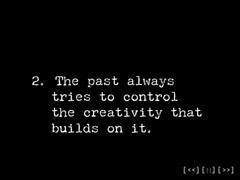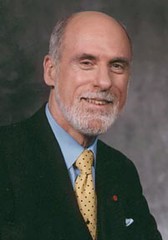the school administrators dilemma
"the best way to predict the future is to create it"On the one hand education departments are calling for innovation, change, creating the future, constructivism, more emphasis on engagement with less emphasis on content. On the other hand they are blocking one of the most important sources of the creativity (the read / write web) that they profess to crave for. Does the left hand understand what the right hand is doing? Probably not. It's far more likely that the "progressive theorists" are talking on a different wavelength to the hardnose technocrats. In short, the system is failing us.
... with the release of the Department's Statement of Directions, 2005-2010 we have chosen to embrace similar sentiments.
There is a problem, but indiscriminate blocking of the internet is not the solution. Education Department administrators need to be more creative and flexible in finding solutions to real problems.
It is true that not all teachers are internet savvy. It is true that not all teachers supervise what their students are doing closely when in computer rooms. It is true that some students know more about computers than some teachers and are doing all sorts of off task and perhaps offensive searches in the computer rooms. These might be issues that the education profession does not want to talk about, but nevertheless, they are true statements.
These are real problems.
The South Australian education department has responded to these problems by imposing filtering software (N2H2 / Bess) that allows for no differentiation between teachers and students, no differentiation between primary, secondary and senior colleges and no differentiation between experienced web savvy IT teachers and teachers who are computer reticent or phobic. These settings cannot be altered. Whatever is blocked is blocked for everybody. Whatever is allowed is allowed for everybody.
Although web sites and groups of sites can be unblocked and blocked at individual campuses the problem remains that there is no differentiation on the above settings allowed within a site and this inflexibility creates huge problems.
Within each campus experienced and knowledgeable IT teachers who do know how to manage their classes searching the web are being treated exactly the same as the students on that campus.
This is an inflexible solution that in solving one problem - stop kids from finding porn on the net - creates another one - stop web savvy teachers who want to innovate and educate using some of the latest, most cutting edge web applications from doing so. It blocks and discourages creative innovation in schools.
It also puts school administrations into a difficult situation. What are they supposed to do when something goes wrong and the teacher involved has been neglectful in some way? If the blocking software was more flexible one possibility would be to permit broader internet access for teachers who are more web savvy. Less confident teachers might also welcome this option to help with a difficult management problem while they improve on their skills. However, rather than a human mediated resolution the software "solves" the problem of trust by trusting no one. School administrations may trust certain teachers to manage the situation but the software does not allow that. The "one size fits all" software takes the power out of the hands of local school administrations. So the simplest solution is to block everything that might be dangerous. Never mind if there are 99 wholesome searches of google images, the one sordid search will determine policy. Where is the trust in our educational professionals: the innovative classroom teachers and forward thinking administrators?
We also have a background environment of fear, where some groups are gearing up to pounce and sue a school when a child is exposed to porn, to create an "example" for others.
Put all this together and we have an educational disaster on our hands. In a fast changing world to delay the future is to disadvantage our students and frustrate our innovative teachers.
Web applications which require ability to write to the web are not the next big thing, they are the current new big thing. Unfortunately, those in the hierarchy who are doing this to us may not understand it. The technocrats may not understand the enormous educational potential. The constructivists may not understand the full implications of modern technology. At the very time when blogs, podcasts, photo sharing and many other web applications are coming on line the education department decides to "play safe" and block the lot. Teachers cannot even explore blogs at school. They have to do that in their own time at home. Encouragement for innovation? Forget it.
An indiscriminate piece of software is telling IT savvy teachers what they can and can't teach, even though they are quite capable of managing these issues successfully.
Since the software is not meeting the real educational needs the only satisfactory immediate option that I can envisage is to change the software.









